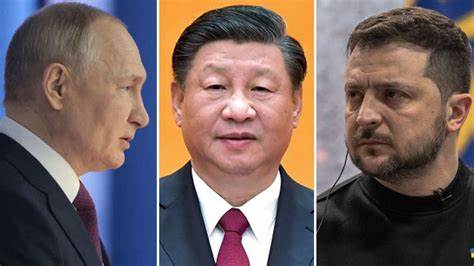Digital Zeitgeist – The Geopolitical Shift: China-Russia Resource Trade Fuels Yuan-Dollar Dynamics Amid Ukraine Fallout
Introduction
In the realm of global economics and geopolitics, the interplay between major powers is constantly evolving. One such noteworthy development lies in the shifting dynamics of resource trade between China and Russia, and its implications on the dominance of the yuan and the dollar. As geopolitical tensions surrounding Ukraine continue to reverberate, this article delves into the vast resources traded between these nations, the growing role of the yuan in international transactions, and the ramifications for global markets.
- The Expansive China-Russia Resource Trade
China and Russia, two economic powerhouses with abundant natural resources, have long shared a symbiotic trade relationship. Their trade cooperation extends beyond traditional goods and encompasses significant exchanges of resources. According to a report by Reuters, Russia supplies China with more than one million barrels of oil per day, making it China’s largest crude oil supplier. Additionally, China has become Russia’s largest trade partner, with bilateral trade reaching over $100 billion in 2022.
Over the years, the bilateral trade between China and Russia has witnessed impressive growth. Chinese investments in resource-rich regions such as Siberia and the Russian Far East have reached billions of dollars, focusing on energy projects, mining operations, and infrastructure development.
- The Yuan’s Ascendancy in Resource Trade
One of the most significant repercussions of the China-Russia resource trade is the increasing role of the yuan as a settlement currency. Historically, the dominance of the U.S. dollar in global transactions has been unquestionable. However, the deepening economic ties between China and Russia have prompted a shift towards conducting trade in their respective national currencies, bypassing the dollar.
According to the Bank of Russia, the share of settlements between China and Russia in yuan has increased from 2% in 2015 to more than 20% in recent years. This shift is driven by the desire to reduce dependence on the dollar and mitigate exchange rate risks. Furthermore, China’s efforts to internationalize the yuan, including establishing offshore yuan clearing banks and expanding its use in cross-border trade, have facilitated its acceptance and usage in global transactions.
III. Geopolitical Implications Amid Ukraine Fallout
The ongoing geopolitical tensions surrounding Ukraine have further influenced the dynamics of the China-Russia resource trade and the role of their currencies. The fallout between Russia and Western powers has led to increased sanctions, trade restrictions, and a growing sense of isolation for Russia. In response, both Russia and China have sought closer economic ties to counterbalance Western pressure.
As Western nations imposed sanctions on Russia, the yuan has emerged as an alternative currency for settling trade between the two nations. According to an article by Bloomberg, Russian oil companies have started accepting payment for oil in yuan, reducing their dependence on the dollar-dominated financial system. This shift not only shields them from potential disruptions caused by sanctions but also aligns with China’s strategic goal of challenging the dollar’s dominance in global transactions.
Moreover, the Ukraine crisis has highlighted the vulnerabilities associated with the dollar’s status as the world’s reserve currency. It has prompted countries, including Russia and China, to explore alternative financial mechanisms that reduce their exposure to the influence of Western powers.
- Global Market Ramifications
The China-Russia resource trade and the corresponding shift in currency dynamics have significant ramifications for global markets. As the yuan gains prominence, its increasing use in international transactions could challenge the dollar’s dominance. This shift may affect the stability of the global financial system, impact currency exchange rates, and redefine the economic influence of major powers.
- Global Market Ramifications
According to a report by the International Monetary Fund (IMF), the yuan’s share in global payments increased to 2.31% in 2022, up from 0.84% in 2015. This growth is driven by China’s efforts to promote the yuan as an international reserve currency and its inclusion in the IMF’s Special Drawing Rights (SDR) basket. As the yuan becomes more widely accepted, it presents an alternative to the dollar for countries seeking to diversify their currency reserves and reduce their exposure to currency risks.
The expanding China-Russia trade relationship has the potential to reshape regional and global supply chains. With China’s reliance on Russian resources, particularly in the energy sector, the trade patterns for commodities such as oil, natural gas, and minerals are shifting. This realignment can impact global commodity prices and disrupt existing market dynamics. For instance, the increase in Chinese demand for Russian oil has already influenced global oil prices.
Furthermore, the growing economic ties between China and Russia have prompted other countries to take notice and assess their own trade and currency strategies. The prospect of an alternative financial system that challenges the dominance of the dollar has attracted interest from nations looking to reduce their vulnerability to geopolitical tensions and economic sanctions.
Conclusion
The evolving resource trade between China and Russia, coupled with the increasing role of the yuan in international transactions, signifies a significant shift in the global economic landscape. As geopolitical tensions surrounding Ukraine persist, these developments carry far-reaching implications for the dominance of the dollar, the stability of global financial systems, and the restructuring of supply chains.
China’s thirst for Russian resources and the subsequent reliance on the yuan for trade settlements have provided a boost to the internationalization of the Chinese currency. The yuan’s growing acceptance challenges the long-standing dominance of the dollar in global transactions, and its increasing use in cross-border trade has the potential to reshape the global financial order.
As the world navigates this evolving landscape, understanding the intricacies of the China-Russia resource trade, the rise of the yuan, and their impact on global markets is paramount. The journey towards a multipolar economic order is underway, and its implications will continue to shape the future of international trade, finance, and diplomacy. As countries reassess their trade and currency strategies, the balance of economic power is being recalibrated, setting the stage for a new era of global economic dynamics.

